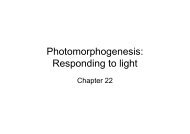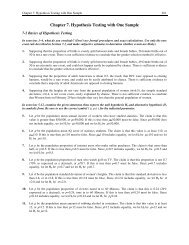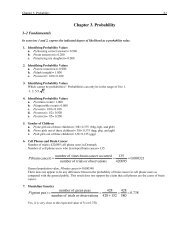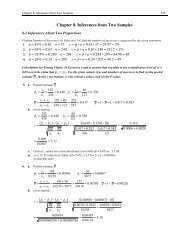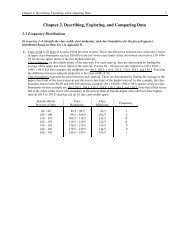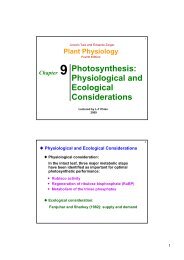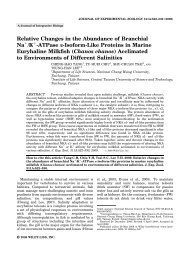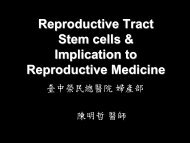Author's personal copy
Author's personal copy
Author's personal copy
You also want an ePaper? Increase the reach of your titles
YUMPU automatically turns print PDFs into web optimized ePapers that Google loves.
This article appeared in a journal published by Elsevier. The attached<strong>copy</strong> is furnished to the author for internal non-commercial researchand education use, including for instruction at the authors institutionand sharing with colleagues.Other uses, including reproduction and distribution, or selling orlicensing copies, or posting to <strong>personal</strong>, institutional or third partywebsites are prohibited.In most cases authors are permitted to post their version of thearticle (e.g. in Word or Tex form) to their <strong>personal</strong> website orinstitutional repository. Authors requiring further informationregarding Elsevier’s archiving and manuscript policies areencouraged to visit:http://www.elsevier.com/<strong>copy</strong>right
<strong>Author's</strong> <strong>personal</strong> <strong>copy</strong>42 W.-K. Yang et al. / Journal of Experimental Marine Biology and Ecology 375 (2009) 41–50and Lee, 2007). NKA in fish gills can be detected by immunocytochemicalstaining, and the number of Na + /K + -ATPase immunoreactive cells (NKA-IR cells) can be counted. Most branchial NKA was found to localize inMRCs; the number and distribution of the NKA-IR cells also changed withenvironmental salinities (Shikano and Fujio, 1998a,d; Sakamoto et al.,2001b; Lin et al., 2003; Hwang and Lee, 2007).For acclimation and survival, fish respond to environmental stressorsat many levels including increasing levels of blood glucose and heatshock proteins (HSPs). Blood glucose is an important source of energyfor the metabolism necessary to maintain physiological homeostasis andcope with environmental changes (Bashamohideen and Parvatheswararao,1972; Kelly et al., 1999). Usually the levels of blood glucose in fishincrease following exposure to stressful environments (Pottinger andCarrick, 1999) such as toxicants (Silbergeld, 1974), artificial habitat(Arends et al., 1999; Kubokawa et al., 1999), abnormal temperature(Tanck et al., 2000; Hsieh et al., 2003), handling or capture (Rotllant andTort, 1997; Frisch and Anderson, 2005; Tintos et al., 2006), and osmoticchallenges (Bashamohideen and Parvatheswararao, 1972; Manceraet al., 1993; Soengas et al., 1995; Woo and Chung, 1995; Morgan andIwama, 1998; Kelly et al., 1999; Claireaux and Audet, 2000; De Boecket al., 2000; Diouf et al., 2000; Palmisano et al., 2000; Yavuzcan-Yıldızand Kırkağaç-Uzbilek, 2001; Sangiao-Alvarellos et al., 2003, 2005;Cataldi et al., 2005; Laiz-Carrión et al., 2005a,b; Arjona et al., 2007; Fiesset al., 2007; Choi et al., 2008). On the other hand, previous studiesindicated that in fish, the HSPs with high molecular weights such as 60,70, and 90 kDa interact with environmental stressors (Iwama et al.,1998,1999; Feder and Hofmann, 1999; Basu et al., 2002), e.g., abnormaltemperature (Dietz,1994; Sathiyaa et al., 2001; Cara et al., 2005; Buckleyet al., 2006; Rendell et al., 2006; Manchado et al., 2008) and externalosmolality challenges (Kültz, 1996; Smith et al., 1999; Palmisano et al.,2000; Pan et al., 2000; Deane et al., 2002; Deane and Woo, 2004;Todgahm et al., 2005; De Jong et al., 2006; Choi and An, 2008). Amongthem, HSP90 constituted about 2% of total cellular protein in allorganisms (Parsell and Lindquist, 1993). HSP90 was active in theenzymes, steroid hormone receptors, and cytoskeleton of variouscomponents of cell signaling and was regarded as an indicator toestimate the level of environmental stressors (Iwama, 1998; Iwamaet al., 2004). Furthermore, HSP90 is expressed in various fish organs(Iwama, 1998; Iwama et al., 1999) including gill (Dietz, 1994; Kültz,1996; Palmisano et al., 2000; Pan et al., 2000; Buckley et al., 2006; Choiand An, 2008)andliver(Dietz, 1994; Palmisano et al., 2000; Sathiyaa etal., 2001; Deane et al., 2002; Deane and Woo, 2004; Rendell et al., 2006;Wang et al., 2007). The liver is an important organ with more diversefunctionality than any other organ in the fish body, possible due to itslarge size, rich enzymatic content, HSP-sensitivity, and capacity forglycogen storage (Bond, 1996; Bruslé and Anadon, 1996; Iwama, 1998;Mwase et al.,1998; Sangiao-Alvarellos et al., 2003). Elevated branchial orhepatic HSP90 expression (protein or mRNA level) upon salinitychallenge was reported as an indicator of osmotic stress in teleosts(Palmisano et al., 2000; Pan et al., 2000; Deane et al., 2002; Choi and An,2008).The sailfin molly (Poecilia latipinna) is a livebearing species withlarge dorsal fins on the males (Nelson, 1984; Berra, 2001; Froese andPauly, 2008). They are natively distributed in low elevations fromNorth Carolina, USA, to Veracruz, Mexico (Nordlie et al., 1992; Ptacekand Breden, 1998; Froese and Pauly, 2008) and have been introducedto many countries (Froese and Pauly, 2008) including Taiwan (Shao,2008). Today the euryhaline sailfin molly is found in the shallowsurface water along the edges of lowland, ponds, streams, gullies,swamps, salt marshes, and estuaries (Nordlie et al., 1992; Froese andPauly, 2008). In Taiwan, the sailfin molly was mainly distributed in thelower reaches (FW) and river mouths (brackish water, BW) over thesouthwestern part (Shao, 2008). Similar to the other euryhalineteleosts, branchial NKA activity and plasma osmolality of SW sailfinmolly were found to be elevated with increasing salinity such ashypersaline water (Gonzalez et al., 2005). Moreover, branchial NKAactivity was thought to regulate physiological homeostasis whenindividuals were exposed to salinity/osmotic stress. Hence wehypothesized that branchial NKA expression of sailfin molly changedin response to salinity stress for homeostasis so that they were able tosurvive in environments of different salinities. The goal of the presentstudy was to profile the osmoregulatory mechanisms of the sailfinmolly upon salinity challenge by indicators including physiologicalparameters (plasma osmolality and muscle water content), biochemicalexpression (activity, α-subunit protein abundance, and immunoreactivecells of branchial NKA), and stress responses (plasma glucoseconcentrations and protein abundance of hepatic and branchialHSP90).2. Materials and methods2.1. Fish and experimental environmentsAdult sailfin molly (P. latipinna) of3.1±0.4gbodyweightand51.2 ± 27.3 mm standard length were captured from Linyuan, Kaohsiung,Taiwan (120.38° E 22.49° N) and transported to the laboratory.Seawater (35‰) and brackish water (15‰; BW) were prepared fromlocal tap water by adding standardized amounts of synthetic sea salt“Instant Ocean” (Aquarium Systems, Mentor, OH, USA). The fish werereared in BW at 25±1 °C for one week in the laboratory and thenacclimated to either fresh water (FW), BW, or SW with a daily 12 hphotoperiod for at least 4 weeks before sampling for the following testsand analyses. The parameters of the water were identical to our previousstudy (Wang et al., 2008). The water was continuously circulatedthrough fabric-floss filters and partially refreshed every three days. Fishwere fed a daily diet of commercial pellets ad libitum. In order toperform the following experiments, fish were fully anesthetized withMS-222 (100–200 mg/L) and placed on ice before sampling.2.2. Plasma analysesFish blood was collected from the caudal veins with heparinized1 ml syringes and 27 G needles. After centrifugation at 13,000 g, 4°Cfor 20 min, the plasma was stored at −20 °C prior to analysis. Plasmaosmolality was measured with the Wescor 5520 vapro osmometer(Logan, UT, USA). Plasma glucose concentrations were determinedaccording to the manufacturer's protocol (Sigma, St. Louis, MO, USA)using a Hitachi U-2001 spectrophotometer (Tokyo, Japan).2.3. Muscle water content (MWC)The muscle from the dorsum of the body of the adult fish of FW-,BW-, and SW-acclimated groups was sampled and muscle watercontent was determined as the percentage of weight loss after dryingat 100 °C for three days.2.4. Sample preparationThe gills and livers were dissected and rinsed in phosphate bufferedsaline (PBS; concentrations in mmol·l −1 : NaCl:137; KCl: 3; Na 2 HPO 4 :10; KH 2 PO 4 : 2; pH 7.4). The tissues were then blotted dry before furtheranalysis. The gills were fixed in 10% formalin for immunocytochemicaldetection or homogenized for immunoblotting and other analyses; thelivers were homogenized for immunoblotting. The gill and liverscrapings were suspended in the mixture of homogenization medium(concentrations in mmol·l −1 :imidazole-HCl:100;Na 2 EDTA: 5; sucrose:200; 0.1% sodium deoxycholate; pH 7.6) and proteinase inhibitor (10 mgantipain, 5 mg leupeptin, and 50 mg benzamidine dissolved in 5 mlaprotinin) (v/v: 100/ 1). Homogenization was performed in 2 mlmicrotubes with a Polytron PT1200E (Kinematica, Lucerne, Switzerland)at maximal speed for 30 s The homogenate was thencentrifuged at 13,000 g, 4°Cfor20min.Thesupernatantswere
<strong>Author's</strong> <strong>personal</strong> <strong>copy</strong>W.-K. Yang et al. / Journal of Experimental Marine Biology and Ecology 375 (2009) 41–5043used for determination of protein concentrations, enzyme activity, orimmunoblotting. Protein concentrations were identified by reagentsfrom BCA Protein Assay (Pierce, Hercules, CA, USA), using bovineserum albumin (BSA) as a standard (Pierce). The samples werestored at −80 °C before use.2.5. Optimal conditions for determining Na + /K + -ATPase (NKA) activityFor determining the optimal concentrations of Na + ,K + , and Mg 2+in the reaction medium of in vitro assay of molly NKA activity, 0.1 mlfiltered homogenates and 5 ml reaction medium (concentrationsin mmol·l − 1 : imidazole-HCl buffer: 100; pH 7.0; NaCl: 0–300; KCl:0–300; MgCl 2 : 0–30; Na 2 ATP: 5) were mixed. Each reactioncondition was repeated. The reactions with the samples exposed todifferent environments of [Na + ], [K + ], or [Mg 2+ ]wererunat37°Cfor 30 min. The reactions were then stopped by the addition of 2 mlice-cold 30% trichloroacetic acid. The reaction tube was centrifugedand the inorganic phosphate concentration in the supernatant wasdetermined with a spectrophotometer at 700 nm according to themethod proposed by Peterson (1978). TheenzymeactivityofNKAwas defined as the difference between the inorganic phosphateliberated in the presence and absence of 3.75 mmol·l − 1 ouabain inthe reaction mixture. All experiments were repeated 2–4timeswithsimilar results. For comparisons, enzymatic activities were convertedinto relative activities (%) of the highest value obtained ineach experiment. Individual points of concentrations in each panelwere the averages of duplicate samples.2.6. Assay of NKA activityAliquots of the suspension of branchial homogenates, prepared asdescribed above, were used for assaying protein concentrations andenzyme activities. NKA activity was assayed by adding the supernatantto the optimal reaction medium (concentrations in mmol·l − 1 :imidazole-HCl buffer: 100; pH 7.6; NaCl: 200; KCl: 150; MgCl 2 :5;Na 2 ATP: 5). The reaction was run as described above. Each sample wasassayed in triplicate. NKA activity was expressed as μmol inorganicphosphate released per mg of protein per hour.2.7. AntibodiesThe primary antibodies used in this study included (1) NKA: amouse monoclonal antibody (α5; Developmental Studies HybridomaBank, Iowa City, IA, USA) raised against the α-subunit of the avianNKA; (2) heat shock protein 90 (HSP90): a rabbit polyclonal antibody(#4874; Cell Signaling, Beverly, MA, USA) raised against the humanHSP90. The secondary antibodies for immunoblotting were alkalinephosphatase (AP)-conjugated goat anti-mouse IgG or goat anti-rabbitIgG (Chemicon, Temecula, CA, USA).2.8. ImmunoblottingFor immunoblotting of branchial NKA, aliquots containing 25 µg ofbranchial homogenates were added to sample buffer and heated at 60 °Cfor 15 min followed by electrophoresis on 7.5% sodium dodecyl sulfate(SDS)-polyacrylamide gel. The pre-stain protein molecular weightmarker was purchased from Fermentas (SM0671; Hanover, MD, USA).Separated proteins were transferred from unstained gels to PVDFmembranes (Millipore, Bedford, MA, USA) by electroblotting using atank transfer system (Mini Protean 3, Bio-Rad, Hercules, CA, USA). Blotswere preincubated for 2 h in PBST (phosphate buffer saline with Tween20) buffer (concentrations in mmol·l −1 : NaCl:137; KCl: 3; Na 2 HPO 4 :10;KH 2 PO 4 : 2; 0.05% (vol/vol) Tween 20, pH 7.4) containing 5% (wt/vol)nonfat dried milk to minimize non-specific binding, then incubated at4 °C with the primary antibody (α5) diluted in 1% BSA and 0.05% sodiumazide in PBST (1: 2500) overnight. The blot was washed in PBST, followedby a 1-h incubation with AP-conjugated secondary antibody diluted4000x in PBST. Blots were visualized after incubation with an NBT/BCIPkit (Zymed, South San Francisco, CA, USA).For immunoblotting of HSP90, sample buffers were mixed withaliquots containing 20 or 50 µg of hepatic or branchial homogenates. Thehomogenates were then heated at 95 °C for 5 min and fractionated byelectrophoresis on 7.5% SDS-polyacrylamide gels. The following protocolwas identical to that of branchial NKA α-subunit immunoblotting exceptthat the primary antibody to HSP90 was diluted 1000×.Immunoblots were scanned and imported as TIFF files. Immunoreactivebands were analyzed using MCID software version 7.0, rev. 1.0(Imaging Research, Ontario, Canada). The results were converted tonumerical values in order to compare the relative protein abundanceof the immunoreactive bands.2.9. Immunohistochemical detectionGills were dissected and fixed for 24 h in 10% formalin in 0.1 Mphosphate buffer (pH 7.2) at 25 °C. Samples were dehydrated througha graded ethanol series, embedded in paraffin, and serial sections of7 µm were mounted on gelatin-coated glass slides. The sections werestained immunohistochemically with the monoclonal antibody (α5)to NKA α-subunit followed by a commercial kit (PicTure, Zymed).Negative control experiments in which PBS (phosphate bufferedsaline) was used instead of the primary antibody were conducted toconfirm the positive results of NKA immunoreactive (NKA-IR) cells.Immunostained sections were observed using a light microscope(Olympus BX50, Tokyo, Japan) and the micrographs were taken with adigital camera (Nikon COOLPIX 5000, Tokyo, Japan).The method of quantification for NKA-IR cells was modified fromour previous studies (Lin et al., 2003, 2006; Tang et al., 2008). Thenumbers of NKA-IR cells were counted on the sections immunostainedas described in the previous paragraph. Preliminary observationsindicated that most NKA-IR cells in gills of the sailfin molly weredistributed in the interlamellar regions of the filaments. Hence,longisections of the gills including lamellae and the cartilages of thefilaments were chosen, and the numbers of immunoreactive cells inthe interlamellar regions of the filaments and the lamellae werecounted. Cell numbers in the interlamellar regions within the range of5 adjacent lamellae (approximately 40–60 µm) were counted and thelengths of the 4 interlamellar regions were measured to normalize cellcounts to a fixed length (50 µm). Results were expressed as numbers ofNKA-IR cells per 50 µm of filaments (interlamellar regions). For eachsample, 10 areas on the filaments including symmetrical interlamellarregions were randomly selected.2.10. Statistical analysisValues were compared using a one-way analysis of variance (ANOVA)(Tukey's pair-wise method) and Pb0.05 was set as the significant level.Values were expressed as the means±S.E.M. (the standard error of themean) unless stated otherwise.3. Results3.1. Physiological parametersThe plasma osmolality of sailfin molly increased with environmentalsalinities (Fig. 1A). The muscle water content (MWC), however, wasconstant in either FW-, BW-, or SW-acclimated fish (Fig. 1B).3.2. Branchial Na + /K + -ATPase (NKA) expressionWhen the concentration ratio of Na + :K + was 4:3, the highest enzymeactivity was found at 200 and 150 mmol·l −1 of total Na + and K + ,respectively. Thus optimal concentrations of Na + and K + for the in vitro
<strong>Author's</strong> <strong>personal</strong> <strong>copy</strong>44 W.-K. Yang et al. / Journal of Experimental Marine Biology and Ecology 375 (2009) 41–503.3. Plasma glucose concentrations and HSP90 abundance in liversand gillsThe plasma glucose concentrations of sailfin molly elevated withenvironmental salinities that were significantly higher in SWacclimatedfish than the FW fish (Fig. 7).Immunoblotting of HSP90 in livers and gills from fish of differentsalinity-groups (FW, BW, and SW) resulted in a single immunoreactiveband centered at about 90 kDa (Figs. 8A and 9A). Quantification ofimmunoreactive bands revealed that relative protein abundance ofhepatic HSP90 in SW sailfin molly was significantly higher than that ofFW-acclimated fish (Fig. 8B), while the branchial HSP90 proteinFig. 1. Salinity effects on (A) plasma osmolality (N=8) and (B) muscle water content(MWC; N=16) of P. latipinna. Dissimilar letters indicated significant differences amongosmolality of fish acclimated to environments of various salinities (mean±S.E.M., oneway ANOVA with Tukey's comparison, Pb0.05). No significant difference was foundamong MWC of the three salinity groups.assay of NKA activity were 200 and 150 mmol·l −1 , respectively (Fig. 2).The optimal concentration of Mg 2+ required for the NKA activity assaywas determined to be 5 mmol·l −1 , although the relative enzyme activitiesbetween 5 and 10 mmol·l −1 [Mg 2+ ] revealed a difference less than 10%(Fig. 2).The specific activity of branchial NKA of fish acclimated to SW wassignificantly higher than that of fish acclimated to BW and FW (Fig. 3).There was no significant difference, however, between branchial NKAactivity among the BW and FW groups (Fig. 3).Immunoblotting of NKA in gills from the sailfin molly acclimated toenvironments of different salinities (FW, BW, and SW) resulted in asingle immunoreactive band of about 100 kDa (Fig. 4A). Quantificationof immunoreactive bands revealed that the branchial NKA α-subunit protein abundance of SW molly was significantly higher thanthat of FW- or BW-acclimated fish: about 1.7- and 2.2-fold,respectively (Fig. 4B).Salinity effects on the distribution of branchial NKA-immunoreactive(IR) cells were visualized using immunolocalization of the α-subunit onparaffinsections(Fig. 5). The branchial NKA-IR cells of SW-, BW- and FWacclimatedfish were distributed mainly in filaments (the interlamellarregion) and rarely found in lamellae (Fig. 5A–C), and the NKA-IR cellswere not found in either the filaments or the lamellar of the negativecontrol from SW-acclimated fish (Fig. 5D). The number of NKA-IR cells ofSW-acclimated fish was significantly greater than that of BW-acclimatedgroup (Fig. 6). The number of NKA-IR cells of FW-acclimated fish,however, was not significantly different from that in the BW or SWacclimatedgroup (Fig. 6).Fig. 2. Effects of different concentrations of (A) [Na + ], (B) [K + ], and (C) [Mg 2+ ] in theassay of P. latipinna branchial NKA activity. The arrows indicated the optimal ionicconcentrations showing maximal relative ATPase activity.
<strong>Author's</strong> <strong>personal</strong> <strong>copy</strong>W.-K. Yang et al. / Journal of Experimental Marine Biology and Ecology 375 (2009) 41–5047Fig. 6. Densities of NKA-IR cells in gills of P. latipinna acclimated to FW, BW, and SW.Dissimilar letters indicated significant differences among fish of various environments(N=8, mean ±S.E.M., one way ANOVA with Tukey's comparison, Pb0.05).of changing numbers of NKA-IR cells was similar to that of proteinabundance and activity of NKA in gills of sailfinmollyasdescribedabove.Such changes of NKA protein abundance and NKA-IR cells wereconsidered to contribute to alterations in NKA activity for ionoregulation(Dang et al., 2000; Lee et al., 2003; Lin et al., 2003; Laiz-Carrión et al.,2005a; Kang et al., 2008).4.3. Stress responsesWhen exposed to a stressful environment, increased expression ofcertain proteins suggests the presence of stress indicators in fishattempting to adjust to the situation (Iwama et al., 1999, 2004). Thelevels of plasma glucose (Kelly et al.,1999) and hepatic or branchial HSP90expression (Deane et al., 2002; Choi and An, 2008) of teleost, were used toindicate the stress caused by salinity challenge. In this study, higher levelsof plasma glucose and hepatic and branchial HSP90 expression in SWacclimatedsailfin molly showed that the SW environment (non-naturalhabitat) was stressful to this species (Figs.7,8B,9B).Moreover, since the resistant process is energy-demanding, theanimal must mobilize energy substrates for metabolism (Iwama,1998). Plasma glucose could be used as an osmolyte for plasmaosmolality or as an important energy source for metabolism to resistthe stress (Kelly et al., 1999; Diouf et al., 2000). The increasedconcentrations of plasma glucose thus indicated that sailfin mollyacclimating to SW (non-natural habitat) required more energy forbranchial NKA-mediated maintenance of physiological homeostasisFig. 8. (A) Representative immunoblot of P. latipinna livers probed with a polyclonalantibody to HSP90. (B) Relative abundance of immunoreactive bands of HSP90 in livers ofdifferent groups. Dissimilar letters indicated significant differences among fish of variousenvironments (N=10, mean±S.E.M., one way ANOVA with Tukey's comparison, Pb0.05).M, marker (kDa); FW, fresh water; BW, brackish water; SW, seawater.(Fig. 7; Laiz-Carrión et al., 2005a; Sangiao-Alvarellos et al., 2005;Arjona et al., 2007). Temporal patterns of plasma glucose concentrationsfollowing environmental stress, however, varied with teleosteanspecies. Plasma glucose levels can rise quickly and return to normalwithin one day (Rotllant and Tort, 1997; Arends et al., 1999) or fourFig. 7. Salinity effects on plasma glucose levels. Dissimilar letters indicated significantdifferences among fish acclimated to various environments (N=8, mean±S.E.M., oneway ANOVA with Tukey's comparison, Pb0.05).Fig. 9. (A) Representative immunoblot of P. latipinna gills probed with a polyclonalantibody to HSP90. (B) Relative abundance of immunoreactive bands of HSP90 in the gillsfrom different groups. The asterisk indicated a significant difference among groups invarious environments (N=6, mean±S.E.M., one way ANOVA with Tukey's comparison,Pb0.05). M, marker (kDa); FW, fresh water; BW, brackish water; SW, seawater.
<strong>Author's</strong> <strong>personal</strong> <strong>copy</strong>48 W.-K. Yang et al. / Journal of Experimental Marine Biology and Ecology 375 (2009) 41–50days (Mancera et al., 1993; Claireaux and Audet, 2000; Hsieh et al.,2003; Frisch and Anderson, 2005; Sangiao-Alvarellos et al., 2005)after shocks. Higher plasma glucose levels can be maintained over20 days after salinity shocks (Fig. 7; Woo and Chung, 1995; Morganand Iwama, 1998; Kelly et al., 1999; Claireaux and Audet, 2000; DeBoeck et al., 2000; Fiess et al., 2007). Consistently higher glucoselevels after transfer illustrated a higher energy demand for acclimatationto the new environment (Soengas et al., 1995; Arjona et al.,2007).Increased expression of HSPs including HSP90 of fish upon transfer toa hyperosmotic environment, suggests a role for HSPs in maintaining thenormal functions of proteins and cells (Iwama et al.,1999). Upon salinitychallenge, HSP90 expression varied differentially among species. HSP90expression in livers (protein amount; Deane et al., 2002) and gills(mRNA abundance; Choi and An, 2008) of black porgy was found to behigher in hypoosmotic environments (BW or FW) than in SW. However,no change in HSP90 mRNA expression was found in the livers and gills ofchinook salmon at one day after transfer from FW to SW (Oncorhynchustshawytscha; Palmisano et al., 2000). On the other hand, the branchialHSP90 mRNA expression in the gills of Atlantic salmon was raised andthen returned to baseline levels within two days after transfer from FWto SW (Pan et al., 2000). HSP90 is abundantly expressed in mosteukaryotes and it performs its role by forming a multiple proteincomplex with ATPase activity as well as cooperating with other HSPs(Wegele et al., 2004). Elevated hepatic and branchial HSP90 expressionin SW-acclimated sailfin molly might play important roles for reachinghomeostasis upon salinity challenge. More evidence such as plasmacortisol levels will be necessary to illustrate the stress response of sailfinmolly upon salinity challenge in future work.5. ConclusionEuryhaline sailfin molly is able to survive in FW, BW, and SW.Moreover, elevated plasma glucose concentrations, as well as branchialand hepatic HSP90 protein abundance, revealed that SW was stressfulthan FW to the sailfin molly. To maintain homeostasis, higher NKAactivity was necessary for ion secretion in gills of the sailfinmollyinSW(the stressful environment). Although the plasma osmolality of sailfinmolly increased with environmental salinities within a tolerated range,the MWC were constant among different salinity groups. These resultsillustrated that the sailfin molly was proved to be an efficientosmoregulator with gill NKA expression altering in response to salinitychallenge to maintain ion and water homeostasis in environments ofdifferent salinities.AcknowledgementsThe monoclonal antibody of Na + /K + -ATPase α-subunit (α5) werepurchased from the Developmental Studies Hybridoma Bank maintainedby the Department of Pharmacology and Molecular Sciences, JohnHopkins University School of Medicine, Baltimore, MD 21205, and theDepartment of Biological Sciences, University of Iowa, Iowa City, IA 52242,under Contract N01-HD-6-2915, NICHD, USA. This study was supportedby a grant from the National Science Council of Taiwan to T.H.L. (NSC 94-2311-B-005-009). [SS]ReferencesArends, R.J., Mancera, J.M., Muñoz, J.L., Wendelaar Bonga, S.E., Flik, G., 1999. The stressresponse of the gilthead sea bream (Sparus aurata L.) to air exposure and confinement.J. Endocrinol. 163, 149–157.Arjona, F.J., Vargas-Chacoff, L., Ruiz-Jarabo, I., Martín del Río, M.P., Mancera, J.M., 2007.Osmoregulatory response of Senegalese sole (Solea senegalensis) to changes inenvironmental salinity. Comp. Biochem. Physiol. A 148, 413–421.Bagherie-Lachidan, M., Wright, S.I., Kelly, S.P., 2008. Claudin-3 tight junction proteins inTetraodon nigroviridis: cloning, tissue-specific expression, and a role in hydromineralbalance. Am. J. Physiol. 294, R1638–R1647.Bashamohideen, M., Parvatheswararao, V., 1972. Adaptations to osmotic stress in thefresh-water euryhaline teleost Tilapia mossambica. IV. Changes in blood glucose,liver glycogen and muscle glycogen levels. Mar. Biol. 16, 68–74.Basu, N., Todgham, A.E., Ackerman, P.A., Bibeau, M.R., Nakano, K., Schulte, P.M., Iwama,G.K., 2002. Heat shock protein genes and their functional significance in fish. Gene295, 173–183.Berra, T.M., 2001. Freshwater Fish Distribution. In Academic Press, London, pp. 337–341.Blanco, G., Mercer, R.W., 1998. Isozymes of the Na + , K + -ATPase: heterogeneity instructure, diversity in function. Am. J. Physiol. 275, F633–F650.Bond,C.E.,1996.BiologyofFishes,2nded.SaundersCollegePub,NewYork,pp.404–412. 425.Bruslé, J., Anadon, G.G., 1996. The structure and function of fish liver. In: Munshi, J.S.D.,Dutta, H.M. (Eds.), Fish Morphology: Horizon of new research. In Science Publishers,New York, pp. 77–93.Buckley, B.A., Gracey, A.Y., Somero, G.N., 2006. The cellular response to heat stress in thegoby Gillichthys mirabilis: a cDNA microarray and protein-level analysis. J. Exp. Biol.209, 2660–2677.Bystriansky, J.S., Richards, J.G., Schulte, P.M., Ballantyne, J.S., 2006. Reciprocal expressionof gill Na + /K + -ATPase α-subunit isoforms α1a and α1b during seawateracclimation of three salmonid fishes that vary in their salinity tolerance. J. Exp.Biol. 209, 1848–1858.Cara, J.B., Aluru, N., Moyano, F.J., Vijayan, M.M., 2005. Food-deprivation induces HSP70and HSP90 protein expression in larval gilthead sea bream and rainbow trout.Comp. Biochem. Physiol. B 142, 426–431.Cataldi, E., Mandich, A., Ozzimo, A., Cataudella, S., 2005. The interrelationships betweenstress and osmoregulation in a euryhaline fish, Oreochromis mossambicus. J. Appl.Ichthyol. 21, 229–231.Chang, J.C., Wu, S.M., Tseng, Y.C., Lee, Y.C., Baba, O., Hwang, P.P., 2007. Regulation of glycogenmetabolism in gills and liver of the euryhaline tilapia (Oreochromis mossambicus)during acclimation to seawater. J. Exp. Biol. 210, 3494–3504.Choi, C.Y., An, K.W., 2008. Cloning and expression of Na + /K + -ATPase and osmotic stresstranscription factor 1 mRNA in black porgy, Acanthopagrus schlegeli during osmoticstress. Comp. Biochem. Physiol. B 149, 91–100.Choi, C.Y., An, K.W., Choi, Y.K., Jo, P.G., Min, B.H., 2008. Expression of warm temperatureacclimation-related protein 65-kDa (Wap65) mRNA, and physiological changeswith increasing water temperature in black porgy, Acanthopagrus schlegeli. J. Exp.Zool. A 309, 206–214.Claireaux, G., Audet, C., 2000. Seasonal changes in the hypo-osmoregulatory ability ofthe brook charr: the role of environmental factors. J. Fish Biol. 56, 347–373.Dang, Z., Lock, R.A.C., Flik, G., Bonga, S.E.W., 2000. Na + /K + -ATPase immunoreactivity inbranchial chloride cells of Oreochromis mossambicus exposed to copper. J. Exp. Biol.203, 379–387.De Boeck, G., Vlaeminck, A., Van der Linden, A., Blust, R., 2000. The energy metabolismof common carp (Cyprinus carpio) when exposed to salt stress: an increase inenergy expenditure or effects of starvation? Physiol. Biochem. Zool. 73, 102–111.De Jong, L., Moreau, X., Jean, S., Scher, O., Thiéry, A., 2006. Expression of the heat shockprotein Hsp70 in chloride target cells of mayfly larvae from motorway retentionpond: a biomarker of osmotic shock. Sci. Total Environ. 366, 164–173.Deane, E.E., Woo, N.Y.S., 2004. Differential gene expression associated with euryhalinityin sea bream (Sparus sarba). Am. J. Physiol. 287, R1054–R1063.Deane, E.E., Kelly, S.P., Luk, J.C.Y., Woo, N.Y.S., 2002. Chronic salinity adaptationmodulates hepatic heat shock protein and insulin-like growth factor I expression inblack sea bream. Mar. Biotechnol. 4, 193–205.Dietz, T.J., 1994. Acclimation of the threshold induction temperatures for 70-kDa and 90-kDaheat shock proteins in the fish Gillichthys mirabilis.J.Exp.Biol.188,333–338.Diouf, B., Rioux, P., Blier, P.U., Rajotte, D., 2000. Use of brook char (Salvelinus fontinalis)physiological responses to stress as a teaching exercise. Adv. Physiol. Educ. 23, 18–23.Doneen, B.A., 1981. Effects of adaptation to sea water, 170% sea water and to fresh wateron activities and subcellular distribution of branchial Na + ,K + -ATPase, low- andhigh-affinity Ca ++ -ATPase, and ouabain-insensitive ATPase in Gillichthys mirabilis.J. Comp. Physiol. 145, 51–61.Eddy, F.B., Bath, R.N., 1979. Ionic regulation in rainbow trout (Salmo gairdneri) adaptedto fresh water and dilute sea water. J. Exp. Biol. 83, 181–192.Evans, D.H., Piermarini, P.M., Potts, W.T.W., 1999. Ionic transport in the fish gill epithelium.J. Exp. Zool. 283, 641–652.Evans,D.H.,Piermarini,P.M.,Choe,K.P.,2005.Themultifunctionalfish gill: dominant site ofgas exchange, osmoregulation, acid-base regulation, and excretion of nitrogenous waste.Physiol. Rev. 85, 97–177.Feder,M.E.,Hofmann,G.E.,1999.Heat-shockproteins,molecularchaperones,andthestressresponse:evolutionaryandecologicalphysiology.Annu.Rev.Physiol.61,243–282.Fiess, J.C., Kunkel-Patterson, A., Mathias, L., Riley, L.G., Yancey, P.H., Hirano, T., Grau, E.G.,2007. Effects of environmental salinity and temperature on osmoregulatory ability,organic osmolytes, and plasma hormone profiles in the Mozambique tilapia(Oreochromis mossambicus). Comp. Biochem. Physiol. A 146, 252–264.Fiol, D.F., Kültz, D., 2007. Osmotic stress sensing and signaling in fishes. FEBS J. 274,5790–5798.Freire, C.A., Amado, E.M., Souza, L.R., Veiga, M.P., Vitule, J.R., Souza, M.M., Prodocimo, V.,2008. Muscle water control in crustaceans and fishes as a function of habitat,osmoregulatory capacity, and degree of euryhalinity. Comp. Biochem. Physiol. A149, 435–446.Frisch, A., Anderson, T., 2005. Physiological stress responses of two species of coral trout(Plectropomus leopardus and Plectropomus maculatus). Comp. Biochem. Physiol. A 140,317–327.Froese, R., Pauly, D. (Eds.), 2008. FishBase. World Wide Web electronic publication.www.fishbase.org, version (09/2008).Gonzalez, R.J., Cooper, J., Head, D., 2005. Physiological responses to hyper-saline watersin sailfin mollies (Poecilia latipinna). Comp. Biochem. Physiol. A 142, 397–403.
<strong>Author's</strong> <strong>personal</strong> <strong>copy</strong>W.-K. Yang et al. / Journal of Experimental Marine Biology and Ecology 375 (2009) 41–5049Hiroi, J., McCormick, S.D., 2007. Variation in salinity tolerance, gill Na + /K + -ATPase, Na + /K + /2Cl − cotransporter and mitochondria-rich cell distribution in three salmonids Salvelinusnamaycush, Salvelinus fontinalis and Salmo salar. J. Exp. Biol. 210, 1015–1024.Hirose, S., Kaneko, T., Naito, N., Takeib, Y., 2003. Molecular biology of major componentsof chloride cells. Comp. Biochem. Physiol. B 136, 593–620.Hsieh, S.L., Chen, Y.N., Kuo, C.M., 2003. Physiological responses, desaturase activity, and fattyacid composition in milkfish (Chanos chanos) under cold acclimation. Aquaculture 220,903–918.Hwang, P.P., Lee, T.H., 2007. New insights into fish ion regulation and mitochondrionrichcells. Comp. Biochem. Physiol. A 148, 479–497.Hwang, P.P., Sun, C.M., Wu, S.M., 1988. Characterization of gill Na + –K + -activatedadenosine triphosphatase from tilapia Oreochromis mossambicus. Bull. Inst. Zool. Acad.Sin. 27, 49–56.Hwang, P.P., Sun, C.M., Wu, S.M., 1989. Changes of plasma osmolarity, chlorideconcentration and gill Na + ,K + -ATPase activity in tilapia Oreochromis mossambicusduring seawater acclimation. Mar. Biol. 100, 295–299.Inokuchi, M., Hiroi, J., Watanabe, S., Lee, K.M., Kaneko, T., 2008. Gene expression andmorphological localization of NHE3, NCC and NKCC1a in branchial mitochondriarichcells of Mozambique tilapia (Oreochromis mossambicus) acclimated to a widerange of salinities. Comp. Biochem. Physiol. A 151, 151–158.Iwama, G.K., 1998. Stress in fish. Ann. N.Y. Acad. Sci. 851, 304–310.Iwama, G.K., Thomas, P.T., Forsyth, R.B., Vijayan, M.M., 1998. Heat shock proteinexpression in fish. Rev. Fish Biol. Fish. 8, 35–56.Iwama, G.K., Vijayan, M.M., Forsyth, R., Ackerman, P., 1999. Heat shock proteins andphysiological stress in fish. Am. Zool. 39, 901–909.Iwama, G.K., Afonso, L.O., Todgham, A., Ackerman, P., Nakano, K., 2004. Are hsps suitablefor indicating stressed states in fish? J. Exp. Biol. 207, 15–19.Jacob, W.F., Taylor, M.H., 1983. The time course of seawater acclimation in Fundulusheteroclitus L. J. Exp. Zool. 228, 33–39.Jensen, M.K., Madsen, S.S., Kristiansen, K., 1998. Osmoregulation and salinity effects onthe expression and activity of Na + ,K + -ATPase in the gills of European sea bass,Dicentrarchus labrax (L.). J. Exp. Zool. 282, 290–300.Kang, C.K., Tsai, S.C., Lee, T.H., Hwang, P.P., 2008. Differential expression of branchial Na + /K + -ATPase of two medaka species, Oryzias latipes and Oryzias dancena, with different salinitytolerances acclimated to fresh water, brackish water and seawater. Comp. Biochem.Physiol. A 151, 566–575.Kato, A., Doi, H., Nakada, T., Sakai, H., Hirose, S., 2005. Takifugu obscurus is a euryhaline fuguspecies very close to Takifugu rubripes and suitable for studying osmoregulation. BMCPhysiol. 5, 18.Kelly, S.P., Woo, N.Y.S., 1999. Cellular and biochemical characterization of hyposmoticadaptation in a marine teleost, Sparus sarba. Zool. Sci. 16, 505–514.Kelly, S.P., Chow, I.N.K., Woo, N.Y.S., 1999. Haloplasticity of black seabream (Myliomacrocephalus): hypersaline to freshwater acclimation. J. Exp. Zool. 283, 226–241.Kubokawa, K., Watanabe, T., Yoshioka, M., Iwata, M., 1999. Effects of acute stress onplasma cortisol, sex steroid hormone and glucose levels in male and female sockeyesalmon during the breeding season. Aquaculture 172, 335–349.Kültz, D., 1996. Plasticity and stressor specificity of osmotic and heat shock responses ofGillichthys mirabilis gill cells. Am. J. Physiol. 271, C1181–C1193.Laiz-Carrión, R., Guerreiro, P.M., Fuentes, J., Canario, A.V.M., Martín del Río, M.P.,Mancera, J.M., 2005a. Branchial osmoregulatory response to salinity in the giltheadsea bream, Sparus auratus. J. Exp. Zool. 303A, 563–576.Laiz-Carrión, R., Sangiao-Alvarellos, S., Guzmán, J.M., Martín del Río, M.P., Soengas, J.L.,Mancera, J.M., 2005b. Growth performance of gilthead sea bream Sparus aurata indifferent osmotic conditions: implications for osmoregulation and energy metabolism.Aquaculture 250, 849–861.Langdon, J.S., 1987. Active osmoregulation in the Australian bass, Macquaria novemaculata(Steindachner), and the golden perch, Macquaria ambigua (Richardson) (Percichthyidae).Aust. J. Mar. Freshw. Res. 38, 771–776.Lee, T.H., Hwang, P.P., Shieh, Y.E., Lin, C.H., 2000. The relationship between ‘deep-hole’mitochondria-rich cells and salinity adaptation in the euryhaline teleost, Oreochromismossambicus. Fish Physiol. Biochem. 23, 133–140.Lee, T.H., Feng, S.H., Lin, C.H., Hwang, Y.H., Huang, C.L., Hwang, P.P., 2003. Ambientsalinity modulates the expression of sodium pumps in branchial mitochondria-richcells of Mozambique tilapia, Oreochromis mossambicus. Zool. Sci. 20, 29–36.Leray, C., Colin, D.A., Florentz, A., 1981. Time course of osmotic adaptation and gillenergetics of rainbow trout (Salmo gairdneri R) following abrupt changes in externalsalinity. J. Comp. Physiol. 144, 175–181.Lin, C.H., Lee, T.H., 2005. Sodium or potassium ions activate different kinetics of gill Na,K-ATPase in three seawater- and freshwater-acclimatized euryhaline teleosts. J.Exp. Zool. A 303, 57–65.Lin, Y.M., Chen, C.N., Lee, T.H., 2003. The expression of gill Na, K-ATPase in milkfish,Chanos chanos, acclimatized to seawater, brackish water and fresh water. Comp.Biochem. Physiol. A 135, 489–497.Lin, C.H., Huang, C.L., Yang, C.H., Lee, T.H., Hwang, P.P., 2004a. Time-course changes inthe expression of Na + ,K + -ATPase and the morphometry of mitochondrion-richcells in gills of euryhalie tilapia (Oreochromis mossambicus) during freshwateracclimation. J. Exp. Zool. A 301, 85–96.Lin, C.H., Tsai, R.S., Lee, T.H., 2004b. Expression and distribution of Na, K-ATPase in gillsand kidneys of the green spotted pufferfish, Tetraodon nigroviridis, in response tosalinity challenge. Comp. Biochem. Physiol. A 138, 287–295.Lin, Y.M., Chen, C.N., Yoshinaga, T., Tsai, S.C., Shen, I.D., Lee, T.H., 2006. Short-term effects ofhyposmotic shock on Na + /K + -ATPase expression in gills of the euryhaline milkfish,Chanos chanos (Forsskl, 1775). Comp. Biochem. Physiol. A 143, 406–415.Madsen, S.S., Naamansen, E.T., 1989. Plasma ionic regulation and gill Na + /K + -ATPasechanges during rapid transfer to sea water of yearling trout, Salmo gairdneri: timecourse and seasonal variation. J. Fish Biol. 34, 829–840.Mancera, J.M., Perez-Figares, J.M., Fernandez-Llebrez, P., 1993. Osmoregulatory responsesto abrupt salinity changes in the euryhaline gilthead sea bream (Sparus aurata L.).Comp. Biochem. Physiol. A 106, 245–250.Manchado, M., Salas-Leiton, E., Infante, C., Ponce, M., Asensio, E., Crespo, A., Zuasti, E.,Cañavatea, J.P., 2008. Molecular characterization, gene expression and transcriptionalregulation of cytosolic HSP90 genes in the flatfish Senegalese sole (Soleasenegalensis Kaup). Gene 416, 77–84.Marsigliante, S., Muscella, A., Vilella, S., Storelli, C., 2000. Dexamethasone modulates theactivity of the eel branchial Na + /K + ATPase in both chloride and pavement cells.Life Sci. 66, 1663–1673.Marshall, W.S., 2002. Na + ,Cl − ,Ca 2+ and Zn 2+ transport by fish gills: retrospectivereview prospective synthesis. J. Exp. Zool. 293, 264–283.Marshall, W.S., Bryson, S.E., 1998. Transport mechanisms of seawater teleost chloridecells: an inclusive model of a multifunctional cell. Comp. Biochem. Physiol. A 119,97–106.Miller, S.A., Harley, J.P., 2002. Zoology. 5th ed. McGraw-Hill Companies, New York, pp. 275–283,425–426, 452–453, 461–463.Morgan, J.D., Iwama, G.K., 1998. Salinity effects on oxygen consumption, gill Na + ,K + -ATPase and ion regulation in juvenile coho salmon. J. Fish Biol. 53, 1110–1119.Mwase, M., Viktor, T., Norrgren, L., 1998. Effects on tropical fish of soil sediments fromKafue River, Zambia. Bull. Environ. Contam. Toxicol. 61, 96–101.Nelson, J.S.,1984. Fishes of the World, 2nd ed. John Wiley & Sons, New York, pp. 214–222. 418.Nilsen, T.O., Ebbesson, L.O., Madsen, S.S., McCormick, S.D., Andersson, E., Björnsson, B.T.,Prunet, P., Stefansson, S.O., 2007. Differential expression of gill Na + ,K + -ATPase α-andβ-subunits, Na + ,K + ,2Cl − cotransporter and CFTR anion channel in juvenileanadromous and landlocked Atlantic salmon Salmo salar. J. Exp. Biol. 210, 2885–2896.Nordlie, F.G., Haney, D.C., Walsh, S.J., 1992. Comparisons of salinity tolerance andosmotic regulatory capabilities in populations of sailfin molly (Poecilia latipinna)from brackish and fresh waters. Copeia 1992, 741–746.Palmisano, A.N., Winton, J.R., Dickhoff, W.W., 2000. Tissue-specific induction of Hsp90mRNA and plasma cortisol response in chinook salmon following heat shock,seawater challenge, and handling challenge. Mar. Biotechnol. 2, 329–338.Pan, F., Zarate, J.M., Tremblay, G.C., Bradley, T.M., 2000. Cloning and characterization ofsalmon hsp90 cDNA: upregulation by thermal and hyperosmotic stress. J. Exp. Zool. A287, 199–212.Parsell, D.A., Lindquist, S., 1993. The function of heat-shock proteins in stress tolerance:degradation and reactivation of damaged proteins. Annu. Rev. Genet. 27, 437–496.Perry, S.F., Shahsavarani, A., Georgalis, T., Bayaa, M., Furimsky, M., Thomas, S.L.Y., 2003.Channels, pumps, and exchangers in gill and kidney of freshwater fishes: their rolein ionic and acid-base regulation. J. Exp. Zool. A 300, 53–62.Peterson, G.L., 1978. A simplified method for analysis of inorganic phosphate in thepresence of interfering substances. Anal. Biochem. 84, 164–172.Pottinger, T.G., Carrick, T.R., 1999. A comparison of plasma glucose and plasma cortisolas selection markers for high and low stress-responsiveness in female rainbowtrout. Aquaculture 175, 351–363.Ptacek, M.B., Breden, F., 1998. Phylogenetic relationships among the mollies (Poeciliidae:Poecilia: Mollienesia group) based on mitochondrial DNA sequences. J. Fish Biol. 53,64–81.Rendell, J.L., Fowler, S., Cockshutt, A., Currie, S., 2006. Development-dependent differencesin intracellular localization of stress proteins (hsps) in rainbow trout, Oncorhynchusmykiss, following heat shock. Comp. Biochem. Physiol., D 1, 238–252.Rotllant, J., Tort, L.,1997. Cortisol and glucose responses after acute stress by net handling inthe sparid red porgy previously subjected to crowding stress. J. Fish Biol. 51, 21–28.Sakamoto, T., Kozaka, T., Takahashi, A., Kawauchi, H., Ando, M., 2001a. Medaka (Oryziaslatipes) as a model for hypoosmoregulation of euryhaline fishes. Aquaculture 193,347–354.Sakamoto, T., Uchida, K., Yokota, S., 2001b. Regulation of the ion-transporting mitochondrialrichcell during adaptation of teleost to different salinities. Zool. Sci. 18, 1163–1174.Sangiao-Alvarellos, S., Arjona, F.J., Martín del Río, M.P., Míguez, J.M., Mancera, J.M.,Soengas, J.L., 2005. Time course of osmoregulatory and metabolic changes duringosmotic acclimation in Sparus auratus. J. Exp. Biol. 208, 4291–4304.Sangiao-Alvarellos, S., Laiz-Carrión, R., Guzmán, J.M., Martin del Río, M.P., Miguez, J.M.,Mancera, J.M., Soengas, J.L., 2003. Acclimation of S. aurata to various salinities altersenergy metabolism of osmoregulatory and nonosmoregulatory organs. Am. J.Physiol. 285, R897–R907.Sathiyaa, R., Campbell, T., Vijayan, M.M., 2001. Cortisol modulates HSP90 mRNA expressionin primary cultures of trout hepatocytes. Comp. Biochem. Physiol. B 129, 679–685.Scheiner-Bobis, G., 2002. The sodium pump. Its molecular properties and mechanics ofion transport. Eur. J. Biochem. 269, 2424–2433.Shao, K.T. (Eds.), 2008. Taiwan Fish Database. WWW Web electronic publication.http://fishdb.sinica.edu.tw, version (10/2008).Shikano, T., Fujio, Y., 1998a. Effect of the mother's environmental salinity on seawatertolerance of newborn guppy Poecilia reticulata. Fish. Sci. 64, 10–13.Shikano, T., Fujio, Y., 1998b. Immunolocalization of Na + ,K + -ATPase and morphologicalchanges in two types of chloride cells in the gill epithelium during seawater andfreshwater adaptation in a euryhaline teleost, Poecilia reticulata. J. Exp. Zool. 281, 80–89.Shikano, T., Fujio, Y., 1998c. Relationships of salinity tolerance to immunolocalization ofNa + ,K + -ATPase in the gill epithelium during seawater and freshwater adaptation ofthe guppy, Poecilia reticulata. Zool. Sci. 15, 35–41.Shikano, T., Fujio, Y., 1998d. Strain differences in seawater adaptability in newbornguppy Poecilia reticulata. Fish. Sci. 64, 987–988.Silbergeld, E.K., 1974. Blood glucose: a sensitive indicator of environmental stress in fish.Bull. Environ. Contam. Toxicol. 11, 20–25.Smith, T.R., Tremblay, G.C., Bradley, T.M., 1999. Hsp70 and a 54 kDa protein (Osp54) areinduced in salmon (Salmo salar) in response to hyperosmotic stress. J. Exp. Zool.284, 286–298.
<strong>Author's</strong> <strong>personal</strong> <strong>copy</strong>50 W.-K. Yang et al. / Journal of Experimental Marine Biology and Ecology 375 (2009) 41–50Soengas, J.L., Aldegunde, M., Andres, M.D., 1995. Gradual transfer to sea water ofrainbow trout: effects on liver carbohydrate metabolism. J. Fish Biol. 47, 466–478.Tanck, M.W.T., Booms, G.H.R., Eding, E.H., Bonga, S.E.W., Komen, J., 2000. Cold shocks: astressor for common carp. J. Fish Biol. 57, 881–894.Tang, C.H., Chang, I.C., Chen, C.H., Lee, T.H., Hwang, P.P., 2008. Phenotypic changes ofmitochondrion-rich cells and responses of Na + / K + -ATPase in gills of tilapiaexposed to deionized water. Zool. Sci. 25, 205–211.Tintos, A., Míguez, J.M., Mancera, J.M., Soengas, J.L., 2006. Development of a microtitreplate indirect ELISA for measuring cortisol in teleosts, and evaluation of stressresponses in rainbow trout and gilthead sea bream. J. Fish Biol. 68, 251–263.Tipsmark, C.K., Madsen, S.S., Seidelin, M., Christensen, A.S., Cutler, C.P., Cramb, G., 2002.Dynamics of Na + ,K + , 2Cl − cotransporter and Na + ,K + -ATPase expression in thebranchial epithelium of brown trout (Salmo trutta) and atlantic salmon (Salmosalar). J. Exp. Zool. 293, 106–118.Tipsmark, C.K., Madsen, S.S., Borski, R.J., 2004. Effect of salinity on expression of branchialion transporters in striped bass (Morone saxatilis). J. Exp. Zool. A 301, 979–991.Tipsmark, C.K., Baltzegar, D.A., Ozden, O., Grubb, B.J., Borski, R.J., 2008a. Salinityregulates claudin mRNA and protein expression in the teleost gill. Am. J. Physiol.294, R1004–R1014.Tipsmark,C.K.,Luckenbach,J.A.,Madsen,S.S.,Kiilerich,P.,Borski,R.J.,2008b.Osmoregulationand expression of ion transport proteins and putative claudins in the gill of southernflounder (Paralichthys lethostigma). Comp. Biochem. Physiol. A 150, 265–273.Todgahm, A.E., Schulte, P.M., Iwama, G.K., 2005. Cross-tolerance in the tidepool sculpin:the role of heat shock proteins. Physiol. Biochem. Zool. 78, 133–144.Uchida, K., Kaneko, T., Miyazaki, H., Hasegawa, S., Hirano, T., 2000. Excellent salinitytolerance of Mozambique tilapia (Oreochromis mossambicus): elevated chloride cellactivity in the branchial and opercular epithelia of the fish adapted to concentratedseawater. Zool. Sci. 17, 149–160.Varsamos, S., Bonga, S.E.W., Charmantier, G., Flik, G., 2004. Drinking and Na + /K +ATPase activity during early development of European sea bass, Dicentrarchuslabrax: ontogeny and short-term regulation following acute salinity changes. J. Exp.Mar. Biol. Ecol. 311, 189–200.Wang, J., Wei, Y., Li, X., Cao, H., Xu, M., Dai, J., 2007. The identification of heat shock proteingenes in goldfish (Carassius auratus) and their expression in a complex environment inGaobeidian Lake, Beijing, China. Comp. Biochem. Physiol. C 145, 350–362.Wang, P.J., Lin, C.H., Hwang, H.H., Lee, T.H., 2008. Branchial FXYD protein expression tosalinity change and its interaction with Na + /K + -ATPase of the euryhaline teleost,Tetraodon nigroviridis. J. Exp. Biol. 211, 3750–3758.Wegele, H., Müller, L., Buchner, J., 2004. Hsp70 and Hsp90—a relay team for proteinfolding. Rev. Physiol., Biochem. Pharmacol. 151, 1–44.Wilson, J.M., Laurent, P., 2002. Fish gill morphology: inside out. J. Exp. Zool. 293, 192–213.Wilson, J.M., Antunes, J.C., Bouça, P.D., Coimbra, J., 2004. Osmoregulatory plasticity ofthe glass eel of Anguilla anguilla: freshwater entry and changes in branchial iontransportprotein expression. Can. J. Fish. Aquat. Sci. 61, 432–442.Wilson, J.M., Leitão, A., Gonçalves, A.F., Ferreira, C., Reis-Santos, P., Fonseca, A.V., da Silva,J.M., Antunes, J.C., Pereira-Wilson, C., Coimbra, J., 2007. Modulation of branchial iontransport protein expression by salinity in the glass eels (Anguilla anguilla L.). Mar.Biol. 151, 1633–1645.Woo, N.Y.S., Chung, K.C., 1995. Tolerance of Pomacanthus imperator to hypoosmoticsalinities: changes in body composition and hepatic enzyme activities. J. Fish Biol.47, 70–81.Yavuzcan-Yıldız, H., Kırkăgaç-Uzbilek, M., 2001. The evaluation of secondary stressresponse of grass carp (Ctenopharyngodon idella, Val. 1844) after exposing to thesaline water. Fish Physiol. Biochem. 25, 287–290.




